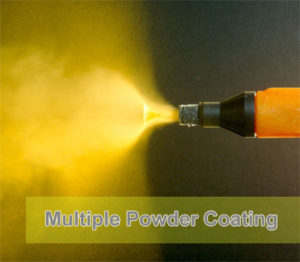
Powder coaters face many challenges as they produce durable, attractive finishes on parts. Different specifications, color-matching, and intended use of the parts all go into the planning and coating processes. Among the biggest challenges is the application of multiple coats to achieve a desired finish. In some cases, a clear coat must be applied to provide extra protection from wear and corrosion. In other cases, two-tone finishes are desired. Candy colors often require a chrome-like base layer to look their best. In this article, tips for applying multiple coats of powder coating will be discussed.
Multiple Coats: the Equipment
In order to achieve the desired finish that requires multiple coats of powder, choosing the right spraying equipment is a primary consideration. Hobbyist powder coating guns may not have the adjustability or the capacity to handle multiple coats. This is due to the fact that the part being coated is insulated from electric charges by the first layer of powder. Professional powder coating services often use a grounding rod to overcome the challenges posed by this insulating layer. To get the best results, professional-level powder coating guns and gear are a must.
Another trick some powder coaters use to overcome the limitations of hobbyist-level guns is to pre-heat the part being coated, then apply a thin second or third layer. The idea behind the pre-heating is that the powder will melt slightly and stick to the base layer. Professionals do not recommend this method, as it can result in finishes that are unsightly and easily chipped or damaged.
Adjusting Voltage for Multiple Coats
Professional-quality powder coating guns are equipped with a means to adjust voltage (called kilovolts, or KV, in the industry). Typically, the first powder coat layer is applied at a certain KV setting, then subsequent coats are applied at a reduced voltage. Often, the second coat is applied at 50% less KV than the first layer. It is a good idea to experiment with KV settings until the ideal setting is achieved; this setting may differ between parts being coated and the type of powder being applied.
Partial Curing During Multiple Coat Applications
For finishes that require multiple layers, particularly for two-tone finishes or those that need a protective clear coat, pre-curing the base layer is a great step to promote adhesion between layers. This also applies for third or fourth coats; between each layer, a partial cure is a step that ensures proper adhesion without peeling or delamination. While the amount of time for a partial cure varies, generally this is about 60% of the required cure time as specified by the powder manufacturer. Timing a partial cure may require an instant-read infrared thermometer, as it is important to start timing the cure only after the part reaches the proper cure temperature.
For chromed finishes, such as the base layer under candy colors, the chrome layer must be fully cured before subsequent powder layers are added. Failure to adequately and fully cure the chrome layer can result in a final finish with a spidery, cracked appearance.
Multiple powder coat layers may be a challenge for amateur powder coaters, but with these tips, an attractive finish is possible. For truly difficult applications, the expertise of a professional powder coating service can be the difference between a durable, beautiful finish and one that peels or cracks easily. For more on powder coating, please click here.









